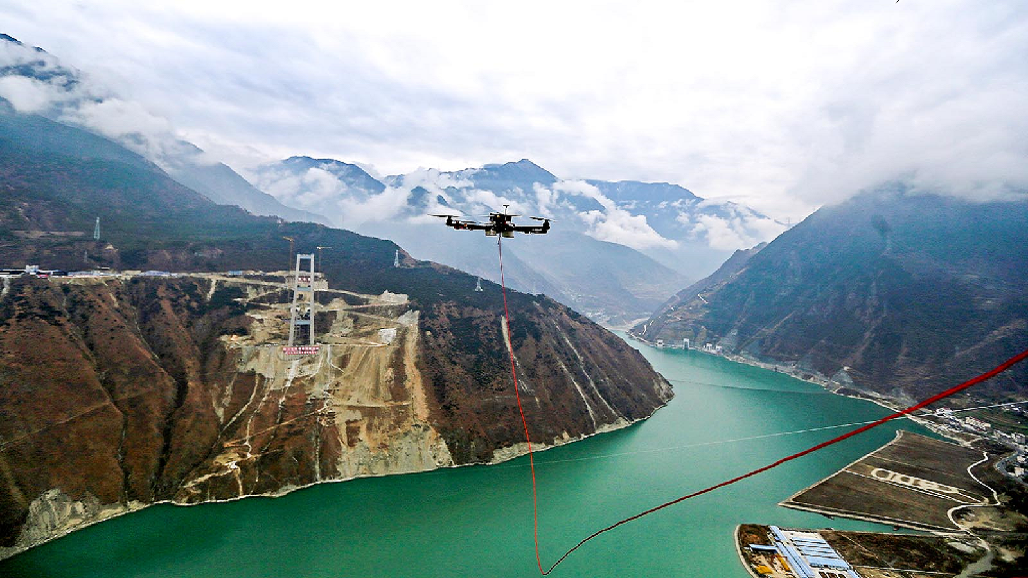Photo: Zhang Jian/Chengdu Economic Daily/VCG
(Photo: An unmanned aerial vehicle towing a cable flies to another side of the Ya’an-Kangding expressway bridge being built in China. Digitization in construction is opening new market opportunities for the industry.)
 Singapore – This piece is the final part of a weeklong series examining the challenges facing infrastructure around the world. Jon Phillips of the Global Infrastructure Investor Association is the series’ guest editor. The previous piece in the series can be read here.
Singapore – This piece is the final part of a weeklong series examining the challenges facing infrastructure around the world. Jon Phillips of the Global Infrastructure Investor Association is the series’ guest editor. The previous piece in the series can be read here.
The construction industry is coming under increasing pressure from several directions at once—and the entire sector is reshaping as a result.
Clients now expect their homes, offices, commercial buildings and infrastructures to be part of their “connected lives.” For instance, buildings need to be more and more individualized, modular and connected to the Internet of Things, and they need to allow for specific performance tracking, optimization of energy and improved security and health parameters.
Explosion of Startups
Sensors, hardware and software have seen costs drop and efficiency rise over the past few years, opening the path to new possibilities. Commercially available technologies such as virtual and augmented reality, drones, robotics and additive printing are more numerous than ever, making it important to separate the more valuable ones from mere novelties.
Encouraged by these trends, startups have taken advantage of market opportunities to provide added value. Oliver Wyman has identified nearly 1,200 startups worldwide since 2010 in real estate and construction. These startups have received around $19.4 billion in funding over the period, half of it in 2017.
Digitization provides a great opportunity to reduce the environmental impact of construction projects as governments increase their CO2 and energy-efficiency regulations. There will also be heightened requirements on data use and cybersecurity in buildings and infrastructure.
Building Information Modeling
Building information modeling (BIM) should be regarded as the backbone of these new ways of working, with different elements—such as various software, drones, construction engines, and building and infrastructure equipment—ultimately connected to it.
BIM—especially 5D, integrating planning and budget—is expected to trigger significant improvement potential in direct costs, quality, delays, and security along the full construction value chain (design, construction, operations and destruction). This potential can be further enhanced if BIM acts as a “cockpit” of a given project, and not as a siloed software. We estimate that, in this case, around 15 percent to 25 percent total cost savings are achievable.
Smart Operations
In operations, digital opportunities are numerous. Interactive work processes such as virtual, augmented and mixed realities as well as dematerialization, in-situ documentation, and connected schedules will be vital. Process efficiency has the potential to drastically increase more efficient, transparent, and rapid collaboration.
All machines and equipment have the potential to ultimately be connected, triggering improvements on dimensions such as maintenance, energy consumption, health and safety incidents, delays or quality. Robotics-related innovations are also being tested and increasingly applied to automate the execution of repetitive tasks and support workers.
Construction tends to industrialize through prefabrication, modular production or 3D printing, which is, without doubt, a big opportunity to increase the productivity in the sector.
Digitization is not only about technologies—it is also about organization, processes and people. Shifting the company’s culture is what’s really at stake.
Digital is often considered as being about operations first. This way of thinking can easily be understood, as construction companies are traditionally driven and ruled by their construction sites.
However, the time of contractors ruled by “site production” without marketing functions is long past. Similar to other businesses, they now need to rethink the customer experience and find innovative offerings. While we are not in the consumer-packaged goods market yet, client centricity is definitely a disruptive and long-lasting market trend in the industry.
Reinventing Ways of Working
Digitization is not only about technologies—it is also about organization, processes and people. But even that is not enough; shifting the company’s culture is eventually what’s really at stake. Based on our experience, we have identified different key success factors to enable long-lasting digital change:
- Make it a top management-supported project
The journey ahead is being driven by cultural shifts that reach far beyond isolated tests. Hence, it has to be directly led by the leadership team to demonstrate its importance, avoid roadblocks, and ensure that the means for success are provided.
- Create a central digital function
The centralized vision has to be carried by a new function that holds the operational responsibility of the project and symbolizes the change. In this respect, we are often asked by our clients whether the IT department should be in command of the change. While IT is, of course, a core part of it, we support the implementation of a new department that handles BIM, digital operations, digital top-line opportunities and organizational and cultural shifts.
- Broaden the network
A digital world is, by definition, open, with diminishing boundaries and raising complexity. To succeed in terms of change, construction industry players need to increasingly think out of the box, generating more partnerships. Value chain positions are no longer constraining, which implies a change of mindset in a traditionally fragmented sector. Appropriate alliances will be one essential trigger for a prosperous evolution.
- Care about data
Digitization will generate significant amounts of information. This information will be more and more immediate and cover a large variety of topics. This represents a huge opportunity to generate new value, but requires adapted processes and a specific focus. Without a change in mindset and a structured approach, one can easily and quickly lose their way or even drown under the amount of information generated.
Conclusion
Digitization in the construction world is in its infancy.
While innovation is booming, it is scattered and unorganized. Nonetheless, digital tools in construction will eventually generate breakthroughs that we simply cannot yet conceive.
Keyword: Infrastructure Internet Of Things
 David Kaufmann
David Kaufmann
Partner at Oliver Wyman
David Kaufmann is a partner with Oliver Wyman in Paris. He is both French and German and advises clients related to the construction ecosystem (such as promoters, contractors, equipment & material providers) on strategic, operational as well as organizational topics. Digital in construction is his current area of focus.
Construction Machines in the Digital Age
 Xavier Ruaux
Xavier Ruaux
Partner at Oliver Wyman
Xavier Ruaux is a partner at Oliver Wyman.
 Michel Jacob
Michel Jacob
Partner at Oliver Wyman
Michel Jacob is a partner at Oliver Wyman.
This article was originally published in Brink Asia website.


Leave a Reply